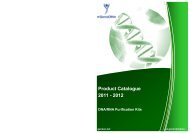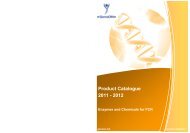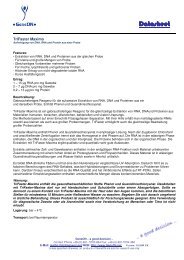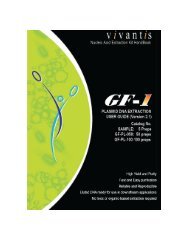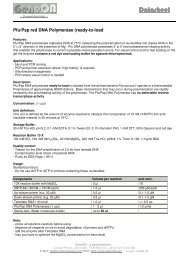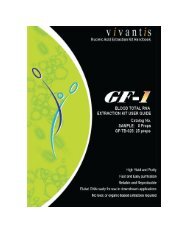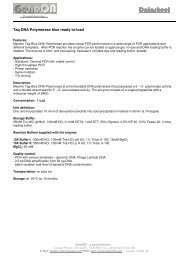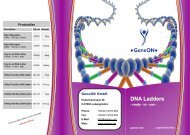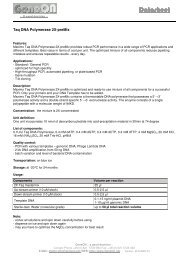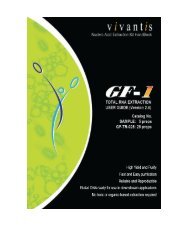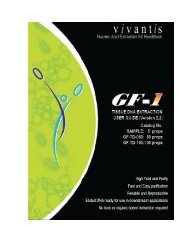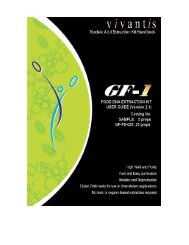Blood DNA purification Kit: Manual
Blood DNA purification Kit: Manual
Blood DNA purification Kit: Manual
You also want an ePaper? Increase the reach of your titles
YUMPU automatically turns print PDFs into web optimized ePapers that Google loves.
IntroductionThe GF-1 <strong>Blood</strong> <strong>DNA</strong> Extraction <strong>Kit</strong> is designed for rapid and efficient <strong>purification</strong> ofgenomic <strong>DNA</strong> from up to 400µl whole blood. This kit uses a specially treated glass filtermembrane fixed into a column to efficiently bind <strong>DNA</strong> in the presence of high salt. This kitapplies the principle of a mini-column spin technology and the use of optimized buffers toensure that only <strong>DNA</strong> is isolated while cellular proteins, metabolites, salts and other lowmolecular weight impurities are removed during the subsequent washing steps.High-purity genomic <strong>DNA</strong> is then eluted in water or low salt buffers and has an A 260/280 ratiobetween 1.7 and 1.9 making it ready to use in many routine molecular biology applicationssuch as restriction enzyme digestion, PCR, Southern blotting, <strong>DNA</strong> fingerprinting, and othermanipulations.<strong>Kit</strong> componentsProductCatalog No5 PrepsSAMPLE50 PrepsGF-BD-050100 PrepsGF-BD-100ComponentsGF-1 columns 5 50 100Collection tubes 5 50 100<strong>Blood</strong> Lysis Buffer 1.5ml 12ml 24ml(Buffer BB)Wash Buffer 11.5ml 15ml 30ml(concentrate)*Wash Buffer 22.4ml 17ml 34ml(concentrate)*Elution Buffer 1.5ml 10ml 20mlProteinase K* 0.11ml 1.05ml 2 x 1.05 mlHandbook 1 1 1* Please refer to Reconstitution of Solutions and Storage and Stability before using this kit.The GF-1 <strong>Blood</strong> <strong>DNA</strong> Extraction <strong>Kit</strong> is available as 50 and 100 <strong>purification</strong>s per kit.The reagents and materials provided with the kit are for research purposes only.
Additional Materials to be Supplied by UserAbsolute Ethanol (>95%)RNase A (DNase-free) (20mg/ml)Reconstitution of SolutionsThe bottle labeled Wash Buffer 1 and Wash Buffer 2 contain concentrated buffer whichmust be diluted with absolute ethanol (>95%) before use.For SAMPLE (5 preps),Add 1.5ml of absolute ethanol into the bottle labeled Wash Buffer 1.Add 5.6ml of absolute ethanol into the bottle labeled Wash Buffer 2.For GF-BD-050 (50 preps),Add 15ml of absolute ethanol into the bottle labeled Wash Buffer 1.Add 40ml of absolute ethanol into the bottle labeled Wash Buffer 2.For GF-BD-100 (100 preps),Add 30ml of absolute ethanol into the bottle labeled Wash Buffer 1.Add 80ml of absolute ethanol into the bottle labeled Wash Buffer 2.Store Wash Buffer at room temperature with bottle capped tight after use.Storage and Stability• Store all solutions at 20°C - 30°C.• Store Proteinase K at -20°C.• <strong>Kit</strong> components are guaranteed to be stable for 12 months from the date ofmanufacture Buffer BB may exhibit salt precipitation due to cold temperature. If thisoccurs, simply warm the bottle at 55°C - 65°C with occasional mixing untilprecipitate is completely dissolved.
Chemical HazardBuffer BB and Wash Buffer 1 contain guanidine salts which can be harmful when in contactwith skin or swallowed. Always wear gloves and practice standard safety precautions. DoNOT disinfect guanidine or extraction waste in solutions containing bleach or any other formof acid.To clean any items contaminated with the reagent, simply soak in detergent and water toremove all traces of guanidine before cleaning with bleach or acidic solutions.
ProceduresReminder• All steps are to be carried out at room temperature unless stated otherwise.• Wash Buffer 1 and Wash Buffer 2 (concentrate) have to be diluted with absolute ethanolbefore use. Please refer to Reconstitution of Solutions.• If precipitation forms in Buffer BB, incubate at 55°C - 65°C with occasional mixing untilprecipitate is completely dissolved.Pre-set waterbath to 65°C.Pre-heat Elution Buffer at 65°C.1. <strong>Blood</strong> lysisAdd 200µl of Bufer BB into a 200µl blood sample in a microcentrifuge tube. Mixthoroughly by pulsed-vortexing. Add 20µl of Proteinase K and mix immediately.Incubate at 65°C for 10 min.Ensure that the Buffer BB is mixed homogeneously with blood sample before addition ofProteinase K. <strong>Blood</strong> samples may vary in the number of leukocytes depending on the donor.Processing too many cells may lead to overloading of the column. Therefore, ensure that thereare not more than 5x10 6 leukocytes inyour sample. Users are not recommended to use more than400µl sample. If the sample volume is more than 200µl, adjust the volume of buffers andProteinase K to be added proportionately.Optional: Removal of RNAIf RNA-free <strong>DNA</strong> is required, add 20µl of RNase A (DNase-Free, 20mg/ml). Mix andincubate at 37°C for 10 min.2. Addition of ethanolAdd 200µl of absolute ethanol. Mix immediately and thoroughly to obtain ahomogeneous solution.Mix immediately to prevent any uneven precipitation of nucleic acids due to high local ethanolconcentrations.
3. Loading to columnAttention! Tips for Higher YieldIn order to obtain maximum yield, we strongly recommend users to fix the orientation ofthe column during centrifugation at all times. We recommend users to place the columnwhich has a triangle mark on the edge, at a fixed position during centrifugation.Transfer the sample into a column assembled in a clean collection tube (provided).Centrifuge at 5,000 x g for 1 min. Discard flow through.4. Column washing 1Wash the column with 500µl Wash Buffer 1 and centrifuge at 5,000 x g for 1 min.Discard flow through.Ensure that ethanol has been added into the Wash Buffer 1 before use (refer to Reconstitution ofSolutions).5. Column washing 2Wash the column with 500µl Wash Buffer 2 and centrifuge at 5,000 x g for 1 min.Discard flow through. Wash column again with 500µl Wash Buffer 2 and centrifuge atmaximum speed for 3 minutes.Ensure that ethanol has been added into the Wash Buffer 2 before use (refer to Reconstitution ofSolutions). Ensure centrifugation for 3 min to remove ethanol completely.6. <strong>DNA</strong> elutionPlace the column into a clean microcentrifuge tube. Add 100µl of preheated ElutionBuffer, TE buffer or sterile water directly onto column membrane and stand for 2 min.Centrifuge at 5,000 x g for 1 min to elute <strong>DNA</strong>. Store <strong>DNA</strong> at 4°C or -20°C.Ensure that the Elution Buffer is dispensed directly onto the center of the membrane for completeelution. TE Buffer can also elute <strong>DNA</strong> although EDTA may inhibit subsequent enzymaticreactions. If water is used for eluting <strong>DNA</strong>, maximum elution efficiency is achieved betweenpH7.0 and 8.5. Store <strong>DNA</strong> at -20°C as <strong>DNA</strong> may degrade in the absence of a buffering agent.
TroubleshootingPlease note that by not adhering to the recommended protocols, unsatisfactory results relatedto yield and quality of <strong>DNA</strong> may occur. If problems arise, please refer to the following:Problem Possibility SuggestionsLow <strong>DNA</strong> yield<strong>Blood</strong> sample is not storedproperlyIncomplete blood lysisAddition of ethanol wasneglectedColumn cloggedColumn not placed at fixedorientation duringcentrifugationProteinase K activity isdecreasedWash Buffer 1 and WashBuffer 2 are applied inwrong orderStore blood sample in smallaliquots to avoid repeated freezethawcycles.Ensure Buffer BB and bloodsample aremixed by pulsedvortexingbefore addition ofProteinase K.Ensure Proteinase K is mixedhomogeneously with the mixture ofBuffer BB and blood sample.Repeat <strong>purification</strong> with new bloodsample.Please refer to the suggestion for‘Incomplete blood lysis.Ensure Wash Buffer 1 is appliedto the column.Place the column which has atriangle mark on the edge, at afixed position during centrifugationat all times.Ensure Proteinase K is stored at -20°C.Ensure Wash Buffer 1 is appliedbefore Wash Buffer 2. Repeat<strong>purification</strong> witha new blood sample.
Problem Possibility SuggestionsWash Buffer 1 and WashBuffer 2 are reconstitutedwronglyColumn is not dried beforeaddition of Elution BufferElution is not performedproperlyPlease refer to the ‘Reconstitutionof Solution’. Repeat <strong>purification</strong>with a new blood sample.Ensure column is spun dry atmaximum speed for 3 minutes afteraddition ofWash Buffer 2.Pre-heat Elution Buffer to 65°C-70°C for eluting <strong>DNA</strong>.Incubate column at roomtemperature for 2 minutes afteraddition of Elution Buffer.Ensure that the Elution Bufferused is a low salt buffer or waterwith a pH range of 7.0 - 8.5.Low Purity (A 260/280 ) Incomplete blood lysis Refer to problem "Low <strong>DNA</strong> yield".<strong>DNA</strong> degradation /smearingPoor performanceof eluted <strong>DNA</strong> indownstream applicationsProteinase K activity isdecreasedWash Buffer 1 is notappliedIncomplete blood lysis<strong>Blood</strong> sample is not storedproperlyEluted <strong>DNA</strong> contains tracesof ethanolTE buffer is used to elute<strong>DNA</strong>. EDTA in TE buffermay inhibit subsequentenzymatic reactionRefer to problem "Low <strong>DNA</strong> yield"Ensure that Wash Buffer 1 isapplied to the column beforeaddition of Wash Buffer 2.Refer to problem "Low <strong>DNA</strong> yield"Refer to problem "Low <strong>DNA</strong> yield".Centrifuge the column at maximumspeed for 3 min during secondwashing of column with WashBuffer 2.Use Elution Buffer or water with apH range of 7.0-8.5.



